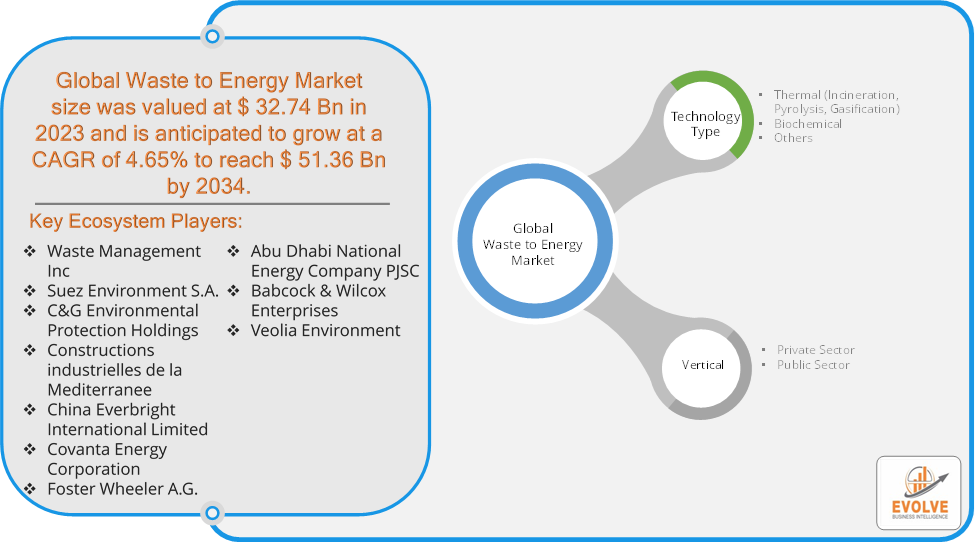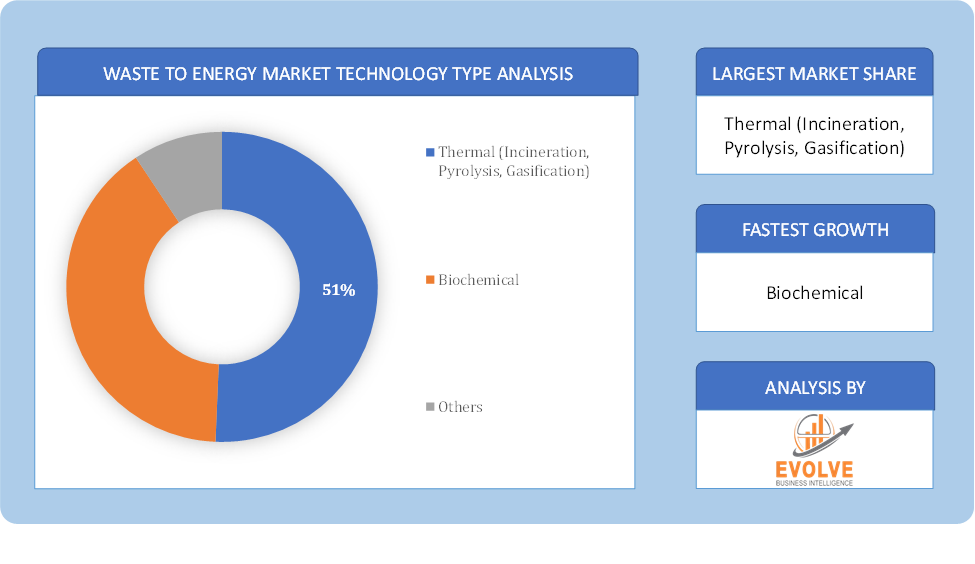Waste to Energy Market Overview
The Waste to Energy Market size accounted for USD 9.68 Billion in 2023 and is estimated to account for 11.03 Billion in 2024. The Market is expected to reach USD 26.21 Billion by 2034 growing at a compound annual growth rate (CAGR) of 4.65% from 2024 to 2034. The Waste-to-energy (WtE) refers to the process of generating energy from waste materials. This energy can take various forms, including electricity, heat, or transportation fuels. WtE plants use a variety of technologies to convert waste into energy, such as combustion, gasification, and pyrolysis.
The market is driven by the need for sustainable waste management solutions, increasing energy demand, and environmental concerns related to landfill use and greenhouse gas emissions. It supports the circular economy by recovering energy from waste that would otherwise contribute to pollution.
Global Waste to Energy Market Synopsis
 Waste to Energy Market Dynamics
Waste to Energy Market Dynamics
The major factors that have impacted the growth of Waste to Energy Market are as follows:
Drivers:
Ø Technological Advancements
Innovations in WtE technologies, such as improved efficiency and lower emissions, enhance the feasibility and attractiveness of these solutions. Rising global energy consumption necessitates the development of alternative energy sources, with WtE providing a renewable energy option. Growing awareness of environmental issues and climate change drives public and corporate acceptance of WtE solutions, leading to increased investment and adoption.
Restraint:
- Perception of High Capital Costs and Technological Limitations
The initial investment required to build and operate WtE facilities can be substantial, deterring potential investors and stakeholders and some WtE technologies may not be suitable for certain types of waste, and existing technologies may require ongoing research and development to improve efficiency and reduce emissions.
Opportunity:
⮚ Circular Economy Initiatives
As businesses and governments adopt circular economy principles, WtE can play a crucial role in resource recovery, creating opportunities for collaboration with industries focused on sustainability. Continued government funding, grants, and policies promoting renewable energy can provide significant financial support for WtE projects, making them more viable. With growing emphasis on reducing greenhouse gas emissions and achieving carbon neutrality, WtE projects can be positioned as part of broader sustainability strategies.
Waste to Energy Market Segment Overview
Based on Technology Type, the market is segmented based on Thermal (Incineration, Pyrolysis, Gasification), Biochemical and Others. The thermal segment dominant the market. The incineration process plays a crucial role in the market by providing a dependable and effective way to convert solid waste into energy. Through the use of elevated temperatures to burn waste products, thermal incineration creates heat that can be harnessed for generating electricity or heating structures. This method decreases the amount of waste that needs to be disposed of and also offers an energy source to meet energy needs and lessen dependence on fossil fuels.
By Vertical
Based on Vertical, the market segment has been divided into Private Sector and Public Sector. The Public Sector segment dominant the market. Public sector organizations often conduct awareness campaigns to educate communities about the benefits of WtE and address concerns related to emissions and health and Involving local stakeholders in decision-making processes can improve public acceptance and support for WtE projects.
Global Waste to Energy Market Regional Analysis
Based on region, the global Waste to Energy Market has been divided into North America, Europe, Asia-Pacific, the Middle East & Africa, and Latin America. North America is projected to dominate the use of the Waste to Energy Market followed by the Asia-Pacific and Europe regions.
 Waste to Energy North America Market
Waste to Energy North America Market
North America holds a dominant position in the Waste to Energy Market. The WtE market in North America is relatively mature, with a focus on MSW incineration. The U.S. and Canada have a well-established WtE market, with significant investments in incineration and anaerobic digestion technologies and there is a growing interest in advanced WtE technologies, such as gasification and pyrolysis and the U.S. and Canada have a well-established WtE market, with significant investments in incineration and anaerobic digestion technologies.
Waste to Energy Asia-Pacific Market
The Asia-Pacific region has indeed emerged as the fastest-growing market for the Waste to Energy Market industry. The WtE market in Asia is expanding rapidly due to increasing urbanization and waste generation and China is the world’s largest WtE market, with numerous large-scale projects. Countries like China, Japan, and India are experiencing rapid urbanization and increasing waste generation, creating significant demand for WtE solutions.
Competitive Landscape
The global Waste to Energy Market is highly competitive, with numerous players offering a wide range of software solutions. The competitive landscape is characterized by the presence of established companies, as well as emerging startups and niche players. To increase their market position and attract a wide consumer base, the businesses are employing various strategies, such as product launches, and strategic alliances.
Prominent Players:
- Waste Management Inc
- Suez Environment S.A.
- C&G Environmental Protection Holdings
- Constructions industrielles de la Mediterranee
- China Everbright International Limited
- Covanta Energy Corporation
- Foster Wheeler A.G.
- Abu Dhabi National Energy Company PJSC
- Babcock & Wilcox Enterprises
- Veolia Environment
Key Development
In June 2022, Veolia continues to establish itself as a world leader in ecological transformation through the sales of Suez’s U.K. waste business unit. The project, which combines Veolia and the majority of Suez’s global operations, focuses on ecological reform.
In April 2024: Babcock & Wilcox Enterprises, Inc. announced that its B&W Environmental segment has been awarded a contract for approximately $15 million to supply environmental equipment for an industrial facility in the Middle East.
Scope of the Report
Global Waste to Energy Market, by Technology Type
- Thermal (Incineration, Pyrolysis, Gasification)
- Biochemical
- Others
Global Waste to Energy Market, by Vertical
- Private Sector
- Public Sector
Global Waste to Energy Market, by Region
- North America
- US
- Canada
- Mexico
- Europe
- UK
- Germany
- France
- Italy
- Spain
- Benelux
- Nordic
- Rest of Europe
- Asia Pacific
- China
- Japan
- South Korea
- Indonesia
- Austalia
- Malaysia
- India
- Rest of Asia Pacific
- South America
- Brazil
- Argentina
- Rest of South America
- Middle East & Africa
- Saudi Arabia
- UAE
- Egypt
- South Africa
- Rest of Middle East & Africa
| Parameters | Indicators |
|---|---|
| Market Size | 2034: USD 51.36 Billion |
| CAGR (2024-2034) | 4.65% |
| Base year | 2022 |
| Forecast Period | 2024-2034 |
| Historical Data | 2021 (2017 to 2020 On Demand) |
| Report Coverage | Revenue Forecast, Competitive Landscape, Growth Factors, and Trends |
| Key Segmentations | Technology Type, Vertical |
| Geographies Covered | North America, Europe, Asia-Pacific, South America, Middle East, Africa |
| Key Vendors | Waste Management Inc, Suez Environment S.A., C&G Environmental Protection Holdings, Constructions industrielles de la Mediterranee, China Everbright International Limited, Covanta Energy Corporation, Foster Wheeler A.G., Abu Dhabi National Energy Company PJSC, Babcock & Wilcox Enterprises and Veolia Environment |
| Key Market Opportunities | · Circular Economy Initiatives · Focus on Carbon Neutrality |
| Key Market Drivers | · Technological Advancements · Public Awareness and Acceptance |
REPORT CONTENT BRIEF:
- High-level analysis of the current and future Waste to Energy Market trends and opportunities
- Detailed analysis of current market drivers, restraining factors, and opportunities in the future
- Waste to Energy Market historical market size for the year 2021, and forecast from 2023 to 2033
- Waste to Energy Market share analysis at each product level
- Competitor analysis with detailed insight into its product segment, Government & Defense strength, and strategies adopted.
- Identifies key strategies adopted including product launches and developments, mergers and acquisitions, joint ventures, collaborations, and partnerships as well as funding taken and investment done, among others.
- To identify and understand the various factors involved in the global Waste to Energy Market affected by the pandemic
- To provide a detailed insight into the major companies operating in the market. The profiling will include the Government & Defense health of the company’s past 2-3 years with segmental and regional revenue breakup, product offering, recent developments, SWOT analysis, and key strategies.







